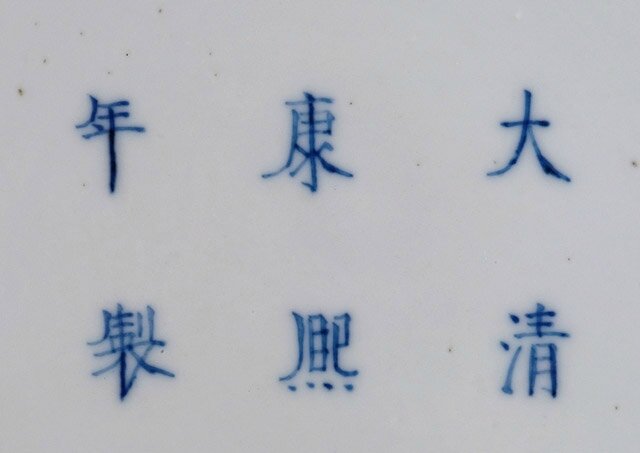A fine peachbloom-glazed beehive waterpot, mark and period of Kangxi (1662-1722)
Lot 652. A fine peachbloom-glazed beehive waterpot, mark and period of Kangxi (1662-1722). D. 12,8 cm. Estimate €15 000/25 000. Lot sold €14 000. Courtesy Nagel.
finely potted of classic domed 'taibai zun' form, the slightly tapering sides rising to a rounded shoulder and short waisted neck below a lipped mouthrim, the exterior decorated overall save for the rim and white base with an even crimson-red glaze characteristically suffused with beige and greyish-pink sprinkles imitating the skin of a ripening peach, the neck bordered with a further thin concentration of beige spots, the body faintly incised with three stylised archaistic dragon roundels, the recessed base inscribed in underglaze blue with a six-character reign mark in three columns. Unglazed sections above the stand otherwise fine condition.
Note: Waterpots of this attractive glaze are known in important museums and collections around the world, including one in the Palace Museum, Beijing, illustrated in Kangxi. Yongzheng. Qianlong. Qing Porcelain from the Palace Museum Collection, Hong Kong, 1989, p. 142, pl. 125; another in the Shanghai Museum, Shanghai, published in Kangxi Porcelain Wares from the Shanghai Museum Collection, Hong Kong, 1998, pl. 206; a third from the Sir Percival David collection and now in the British Museum, London, published in Illustrated Catalogue of Ming and Qing Monochrome Wares, London, 1989, pl. 580; and a further waterpot, from the collections of William B. Jaffe and Evelyn Annenberd Hall, sold at Christie's New York, 29th March 2006.
Waterpots of this type are commonly referred to as taibai zun, after the Tang dynasty poet Li Bai (701-762), who was known as a notorious drinker. Depictions of the poet often show him leaning against a wine jar of this form, as seen with a porcelain sculpture, where the poet is also shown with a cup in hand, in the Palace Museum, Beijing, illustrated in Kangxi. Yongzheng. Qianlong, op. cit., p. 106, pl. 89.
Waterpots of the form belong to a group of eight 'peachbloom' wares for the scholar's desk that became popular in the early Qing dynasty. For a complete set, see Regina Krahl, Chinese Ceramics from the Meiyintang Collection, vol. 4, London, 2010, p. 328
Nagel. Fine Asian Art - Salzburg, 16./17.06.2017

/https%3A%2F%2Fprofilepics.canalblog.com%2Fprofilepics%2F1%2F0%2F100183.jpg)
/https%3A%2F%2Fstorage.canalblog.com%2F03%2F02%2F119589%2F96711876_o.jpg)
/https%3A%2F%2Fstorage.canalblog.com%2F11%2F31%2F119589%2F94773502_o.jpg)
/https%3A%2F%2Fstorage.canalblog.com%2F20%2F83%2F119589%2F94772815_o.jpg)
/https%3A%2F%2Fstorage.canalblog.com%2F26%2F72%2F119589%2F75604929_o.jpg)
/https%3A%2F%2Fstorage.canalblog.com%2F59%2F60%2F119589%2F26458628_o.jpg)




/http%3A%2F%2Fstorage.canalblog.com%2F10%2F66%2F119589%2F122396976_o.jpg)
/http%3A%2F%2Fstorage.canalblog.com%2F80%2F59%2F119589%2F121443569_o.jpg)
/http%3A%2F%2Fstorage.canalblog.com%2F71%2F80%2F119589%2F110062027_o.jpg)
/http%3A%2F%2Fstorage.canalblog.com%2F69%2F45%2F119589%2F106779358_o.jpg)